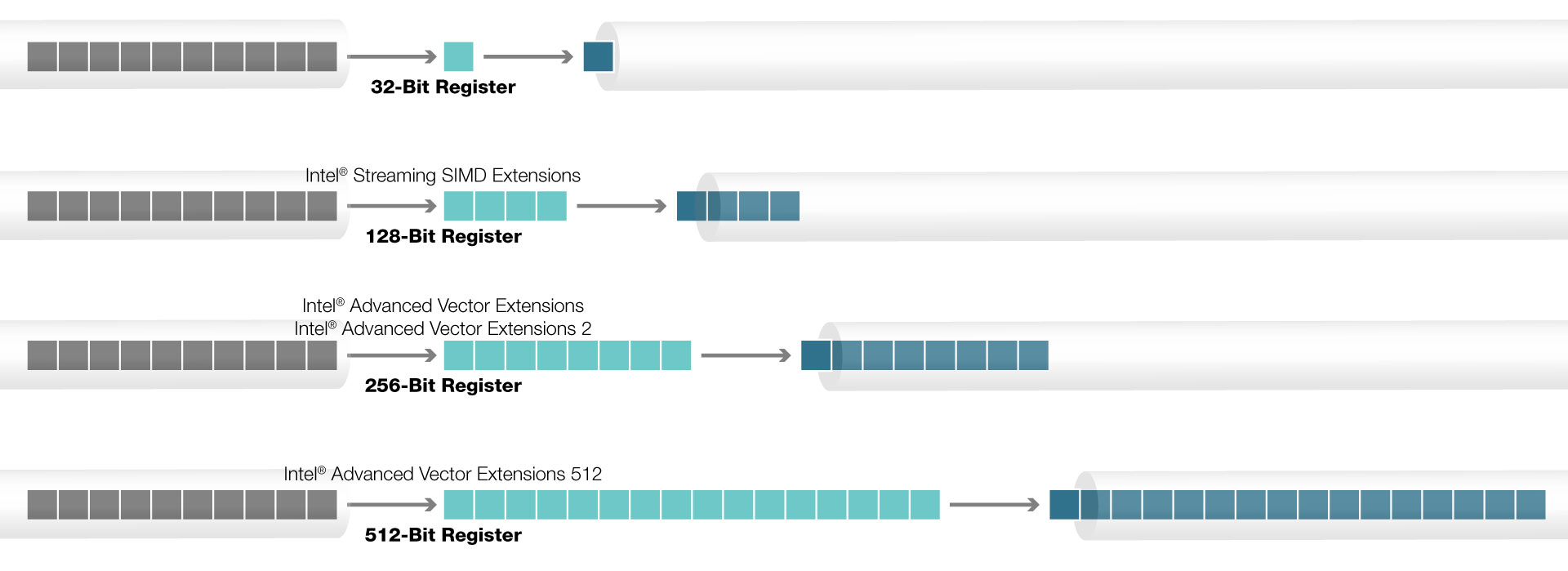- Intel Advanced Vector Extensions 512 (Intel AVX-512)
- Innovation Engine,
- Internet Wide Area Remote Direct Memory Access (RDMA) Protocol (iWARP)
- Intel Volume Management Device (Intel VMD)
- Intel Platform Trust Technology (Intel PTT)
This series of blog posts explores the new features to help explain why Intel says its new server platform represents the “biggest platform advancements in this decade.”
What Is Intel AVX-512?
Intel AVX-512 is a set of new CPU instructions that impacts compute, storage, and network functions. The number 512 refers to the width, in bits, of the register file, which sets the parameters for how much data a set of instructions can operate upon at a time. Intel AVX-512 doubles the width of the register compared to its predecessor, and it also doubles the number of registers to further decrease latency. It also contains additional optimizations to further accelerate tasks for modern workloads.
Intel AVX-512 enables twice the number of floating point operations per second (FLOPS) per clock cycle compared to its predecessor, Intel AVX2. A single register under Intel AVX-512 can hold up to eight double-precision or 16 single-precision floating-point numbers. Or in other words, Intel AVX-512 enables processing of twice the number of data elements that Intel AVX or Intel AVX2 can process with a single instruction, and four times that of Streaming SIMD Extensions (SSE) (see Figure 1).

Figure 1. Intel AVX-512 increases the width of the register 16-fold compared to the original 32-bit register and enables twice the FLOPS enabled by Intel AVX2
Intel AVX-512 can accelerate performance for workloads and use cases such as scientific simulations, financial analytics, artificial intelligence (AI)/deep learning, 3D modeling and analysis, image and audio/video processing, cryptography, and data compression.
Intel AVX-512 can also help data centers more efficiently use available storage resources. Simply put, it accelerates storage functions, such as deduplication, encryption, compression, and decompression. It accomplishes this by doubling the number of bits in the register from 256 to 512 (see an illustrative animation here). In fact, it calculates storage functions in half the time of the previous generation.
This acceleration has a number of use cases:
- 63 times faster high-performance computing*
- 2 times faster AI/deep learning*
- 1 times faster cryptographic hashing performance*
- 2 times faster data protection*
This exceptional processing of encryption algorithms helps reduce the performance overhead for cryptography, which means you can deploy more secure data and services into distributed environments without compromising performance.
You can take advantage of Intel AVX-512 by choosing server platforms based on Intel Xeon Scalable processors. Click here to learn more about the platform. And keep an eye on this blog for the next post in this series, which will discuss the new Intel Innovation Engine.
*Click here for full details of testing and claims.
And, as always, you can keep up on the latest activities at Prowess by reading the Prowess blog and by following Prowess on Twitter and LinkedIn.



